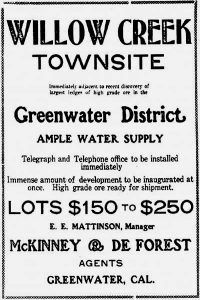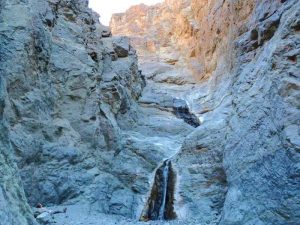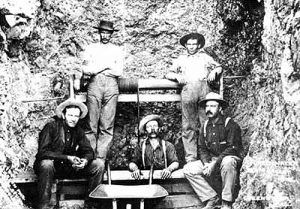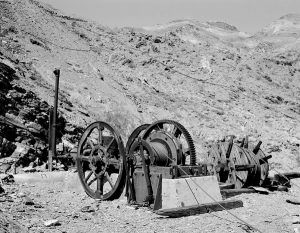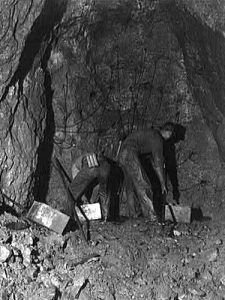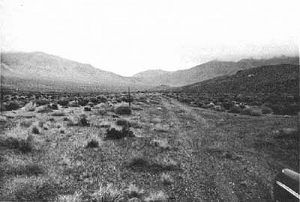The Willow Creek and Gold Valley area, located about ten miles south of Greenwater, California — about 15 miles by road — was the scene of a Greenwater boom in miniature.
Not surprisingly, considering the great water problem in the Greenwater District, the first mention of Willow Creek was not a great mineral location but the discovery of water. In August 1906, just as the Greenwater boom swung into its height, several prospectors who had wandered down to the south reported discovering a good spring of fresh water, which they estimated could supply 3,000-4,000 people. That news immediately attracted more prospectors to the area, for Willow Creek was one of the few good water sources in the southern Death Valley area. If they could not find copper or gold in the vicinity, at least the prospectors would be assured that they would not die of dehydration.
With the Greenwater boom at its peak and a good water source handy, Willow Creek was soon swarming with prospectors, and within a very short time, copper was located in the vicinity of the spring.
By the end of August, a camp had been established at the spring, and several locations had been staked out. Although most prospectors agreed that Willow Creek’s copper was not as good as Greenwater’s, still the Bullfrog Miner proclaimed that “Willow Creek Is the Latest.”
The boom spirit that had thrust Greenwater to the top in such a short time spilled over into the Willow Creek area, and soon, a minor boom was well underway. By the end of September 1906, enough prospectors were in the area to warrant establishing a freight line from Kingston, the newest Tonopah & Tidewater Railroad station. Some of Rhyolite’s leading mining promoters had already moved into the new territory, including Senator T. L. Oddie, who secured a large group of copper claims. Chet Leavitt also moved quickly into Willow Creek from the Lee-Echo District. In addition to staking out numerous claims, Leavitt announced the formation of a townsite company to promote his new town of Copper Basin. Willow Creek’s first mining company, the Greenwater Pasadena Copper Mining Company, was incorporated in September and soon had six men working on several of its 40 claims. The Bullfrog Miner reported that it “is understood that some very high-grade copper ore was uncovered and that there was quite a rush from Greenwater to the discovery scene.
In October 1906, T.L. Oddie started work on his property and paid $30,000 to extend his holdings. On the 4th of that month, he incorporated the Greenwater Arcturus Copper Company, with a capitalization of $3,000,000. Oddie had plenty of competition within a few weeks in the area, as the Greenwater Willow Creek Copper Company was incorporated for $2,000,000 on NovembeNovember 12he Greenwater Baltic Copper Mining Company was incorporated for $1,000,000 on NovembeNovember 14ght idea of the frantic activity accompanying the opening of this subsidiary area may be gained from noting that one man purchased five copper claims for $25,000. The Greenwater Baltic obtained its four claims near the headwaters of Willow Creek for $75,000.
The excitement over these new copper strikes and the ensuing rush into the district caused the inevitable battle over townsite locations. In NovembeNovember, 16ownsite of Willow Creek was organized, near Willow Springs and next to the property of Oddie’s Greenwater Arcturus Copper Company.
Surveyors were immediately put to work laying out a pipeline from the spring to the new townsite, and a pump was ordered. E. E. Mattison promoted the new townsite and immediately placed advertisements in the Rhyolite newspapers, promising prospective citizens an “ample water supply” and telephone and telegraph connections. Lots were put on sale from $150 to $250 each. In this case, the townsite battle was concise, for, with the opening of the Willow Creek townsite, nothing more was heard from Chet Leavitt’s townsite of Copper Basin, which folded overnight.
The mild Willow Creek copper boom continued through the rest of 1906, paralleling the Greenwater boom. On NovembeNovember 30usch brothers of Rhyolite, Nevada, announced the organization of the Greenwater Amalgamated Copper Company, which had 15 claims in the district. Sales of other claims continued. One enterprising prospector managed to unload 15 claims for $30,000 in cash merely due to their proximity to Senator Oddie’s Greenwater Arcturus properties.
Other claims were bought, sold, and traded, and several incorporated mining companies, such as the Greenwater Pasadena and the Greenwater Amalgamated Copper, started to work. By the end of 1906, it was reported that Willow Creek “is going to make a flourishing camp.” Already, the young townsite had three stores, two lodging houses, and three saloons.
The rush into the Willow Creek area subsided during the winter, for the initial copper boom was over. The various companies settled down to look for ore, and since it was now apparent that the copper belt in the Willow Creek area was relatively small, the amount of prospecting in the vicinity tailed off. The Greenwater Arcturus, Senator Oddie’s company, worked steadily through the first several months of 1907, while the other companies worked more sporadically. For example, the Greenwater Amalgamated Copper Company ceased work after barely a month of operation and was never heard of again. At the same time, the Greenwater Willow Creek Copper Company never even began work.
Although the rush to the area had subsided, several more mining companies were organized there, including the Greenwater Clinton Copper Mining Company, the Nevada Greenwater Mining, Milling and Smelting Company, and the Greenwater Guggenheim Copper Company. This last company, which had no connection to the famous Guggenheim family, was quickly denounced by the Death Valley Chuck-Walla as an outright fraud since the three claims it claimed to have in Willow Creek did not exist. The company ceased advertising its non-existent mine shortly after its exposure and was not heard of again.
By the end of March, with the Greenwater Pasadena, the Greenwater Arcturus, the Greenwater Baltic, and the Greenwater Clinton mining companies hard at work, a resident felt safe, boasting that the Willow Creek section would prove to be one of the richest copper mines around Greenwater.
As April passed and May began, the district settled down, with its companies looking for the copper deposits, and Willow Creek looked every bit the picture of a small suburb of Greenwater. However, in May 1907, the picture suddenly changed when the Greenwater Baltic Mining Company discovered a high-grade silver-lead streak on its property.
Copper was one thing, silver was another, and the Willow Creek rush began again. Within a week after the strike on the Baltic was announced, the Bullfrog Miner proclaimed that a “Wild Rush Is On to Willow Creek.” Numerous new locations were made, and several more silver strikes were announced. Another wave of prospectors rolled over the country, looking for the silver indications previously ignored in the initial rush for copper ground. The Greenwater Copperhead Company was formed with silver-lead indications on its claims, and numerous smaller silver mines were opened. To help those rushing into the district, volunteers began working on a wagon road to improve access to the camp.
As the new rush continued, the Bullfrog Miner wrote in mid-May, “Willow Creek Still On The Boom. The New Camp 15 Assuming City Proportions.” The paper said that telegraph and telephone lines would be there soon, and a water company had been organized to pipe water from Willow Springs up to the townsite. The Tonopah & Tidewater Railroad, taking note of the amount of freight now going into the re-booming area, included Willow Creek as one of the freighting points on its new timetable, with teams connecting the townsite with Tecopa Station.
The new rush also caused the older copper companies of the district to re-evaluate their holdings, and new assays were run on their ore, looking for indications of silver or gold, which had been ignored before. By the end of May, with the new and old companies working, the Willow Creek District looked extremely prosperous and full of promise for the future. A petition was being circulated in the area for a new post office, and a movement was underfoot to use the pure water of Willow Creek to start a brewery. In summary, although the Bullfrog Miner noted that the Willow Creek excitement was taking many people away from Greenwater, it cautioned that there were “no deep workings in the camp” as of yet, and more time was needed to demonstrate the permanency of the Willow Creek ores.
At the same time that the new gold and silver finds were causing a new rush to the territory, some of the older copper mines were beginning to close down since the rich surface copper streaks pinched out with depth, just as they did at Greenwater Thus, the Greenwater Pasadena Copper Mining Company ceased work in late May and the Greenwater Copperhead Company in early June. However, the Greenwater Baltic, the Greenwater Arcturus, the Nevada Greenwater, and the Greenwater Clinton continued to work, as most of them discovered enough traces of gold or silver on their properties to warrant further development work.
Even though some of the mines had ceased operations, the Willow Creek townsite continued to be described as looking very prosperous, especially after Harry Ramsey and O. B. Clover made a surface strike of gold about four miles southeast of Willow Spring in June. The gold, which assayed at $200 per ton, caused Ramsey and Clover to claim that they had finally found the “Real and only Breyfogle Mine.”
Several more gold strikes were made quickly, and the Willow Creek area was suddenly transformed from a copper mining camp to a gold camp. With the new promise of riches, the opinion was soon forthcoming from the Bullfrog Miner that the Willow Creek area would “undoubtedly distance Greenwater in a short time.” The Inyo Register reported that the “Latest reports from the scene of the new strike in the Willow Creek District indicate that the surface showing is the richest ever discovered in this desert region, if not in the world.
Gold Valley
The new rush, which soon resulted in numerous small mines opening up, also reintroduced the townsite battle. The Goldsworthy brothers, responsible for one of the bigger gold strikes, announced the formation of the Gold Valley townsite. These brothers did not think small, and when the Inyo County Board approved the plat of their townsite of Supervisors, it showed an immense camp of 96 blocks, with over 1,200 lots surveyed and ready for sale.
As August continued, more gold strikes were reported, and two wise prospectors, taking advantage of the new rush fever, sold their gold claims for $50,000. The rush to the new gold section of the district threatened to eclipse the older copper section entirely, and the Greenwater Arcturus closed down on October 5, as did the Nevada Greenwater Mining, Milling and Smelting Company. In the meantime, the new gold section was booming, and the Gold Valley townsite was described as having a general store and a saloon, with more business slated to come in soon.
By the end of that month, it was pretty clear that gold had replaced copper in the Willow Creek District, “not because they don’t have copper,” said the Bullfrog Miner, “but because copper is down to 15¢ a pound and gold is $248 a pound.” The paper counted 14 gold strikes in the district. It noted that most of the miners and prospectors, wary of the boom and bust cycle of the Greenwater mining companies, were attempting to work their properties without outside financing. It was undoubtedly a wise move, for, in addition to the Greenwater bust, which was beginning to become quite apparent, the Panic of 1907 was also making itself felt in the western mining regions, and investment dollars for new districts and unproven mines were almost impossible to attract.
Despite these problems, several new gold mining companies were incorporated in the fall of 1907, including the Sunset Gold Mining Company in late September, the Willow Creek Gold Mining Company in mid-October, and the Willow Creek Combination Mining and Milling Company in late November. The effects of the panic were drastically shown in the latter company, for it was utterly unable to attract investment dollars and never succeeded in going to work.
In the meantime, miners forged ahead with what means they had available, and the new gold district looked good, considering the times. In October, the new town of Gold Valley added a lodging house and a barbershop to its list of businesses, and the Bullfrog Miner called it “a considerable mining settlement.” Late that month, half a dozen good-looking gold mines were being opened, and the Miner reported eight new strikes being made in the district.
The Greenwater Times stated in early November that only the collapse of the Greenwater District and the effects of the Panic of 1907 kept Willow Creek from really booming. “If it were any other time than now, you would see one of the greatest stampedes in Willow in history, but it is hard to interest people in the way conditions are at this time.” Fully 35 gold strikes and 20 more silver-lead strikes were on record, and a long list of properties were working, although most were small one or two-man operations.
Since the lack of a friendly financial atmosphere kept the great majority of these mines from incorporating and using investors’ dollars to develop their properties, the district as a whole turned to the easing system, whereby the owner would rent his property to anyone willing to work it, in return for some combination of cash rent or a percentage of the ore taken out of the mine. Compared to the more extensive work possible through full-scale development, leasing work was slow and tedious, and the district settled down in the late fall of 1907.
The Rhyolite Daily Bulletin noted in late November, “While the financial depression has affected Willow Creek to a certain extent, the showing is such that work will be continued on many properties.” The reversal to older and small-time mining methods was highlighted by using an arrastra in the district, from which some miners were said to be making as much as $50 per day.
With the reduction of the rush and the lack of capital to develop the mines, the new town of Gold Valley was not growing very fast, although it had succeeded in eclipsing the townsite of Willow Creek. The Rhyolite Herald reported late in December that accommodations at Gold Valley were limited to ten or twelve tents, a store, and a saloon.
As 1908 began, the copper section of Willow Creek, which had been responsible for opening the district originally, was entirely dead, and the only copper companies still operating were those that had subsequently discovered gold or silver on their property.
However, as the new year started, the district looked about as good as possible, considering the nationwide depression following the panic. One of the district’s lessees was about to begin shipping out his high-grade gold ore, and none of the new gold locations made the previous fall had been allowed to lapse. Showings were so good on the property of the Willow Creek Gold Mining Company that its owners began talking about adding a dozen more men to the payroll and building a 15-stamp mill for the mine.
Though development work was necessarily slow, the two townsites got a shot in the arm from the rapid collapse of the Greenwater District. The Rhyolite Daily Bulletin reported that “what buildings remain in Greenwater are being torn down and moved to Gold Valley and the Willow Creek town. With the influx of Greenwater migrants, Gold Valley experienced some growth and, by the end of March, was described as having a population of about 70, with about 20 tent and frame buildings under construction.
With its new prosperity, the citizens of Gold Valley applied for a post office, and the Gold Valley Mercantile Company finished and moved into its new building. Then, in late May 1908, the event that the district had long awaited took place when one of the biggest lessees in the district made the first shipment of ore. Although accounts vary, approximately 25 tons of ore was shipped out, at an estimated worth of around $300 per ton. But, despite this shipment, which first indicated that Willow Creek was becoming a producer, the Bullfrog Miner sadly noted that “Very little outside interest is being manifest in the district.” However, the newspaper noted, “When times get better, Willow Creek will make a noise-like a velocity.”
Unfortunately, times did not get better, and following that one shipment of ore, the Willow Creek District started to decline. No more news was heard from the area between July and December of 1908, and the mines began to close down. For example, the Willow Creek Gold Mining Company ceased operations early in July, and most independent operators were forced to follow its example. Once again, the isolation of the Death Valley mining districts was taking its toll, for the expense of mining, transportation, and living in a desolate region made mining all but the highest grades of ore impractical. The Rhyolite Herald, however, was not quite ready to give up on the district and reported in December that several tons of shipping ore had been taken out of the Greenwater Baltic Mine during the fall of 1908 and that numerous outfits were going back into the district to perform their annual assessment work necessary to retain title to their claims.
Although most prospectors retained their titles through 1909, and the Greenwater Baltic even performed annual work to retain its property through 1910, the Willow Creek District was dead—the victim of hard times, isolation, and too little ore. Most miners left the area during the fall of 1908, and the rest left early in 1909.
Today, little remains of the Willow Creek District, for none of the mines was developed enough to warrant the installation of a gas hoist, and neither of the two townsites boasted any substantial buildings. Only some tailings, scattered debris, and leveled tent sites can be seen today.
Compiled and edited by Kathy Alexander/Legends of America, April 2024.
Primary Source: Greene, Linda W. and Latschar, John A.; Death Valley Historic Resource Study; National Park Service, 1979.
Also See:

